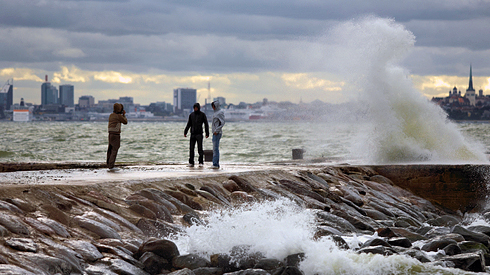"The key to affordable climate protection is to create binding political conditions to take effect immediately for the coming decade." That's how Ottmar Edenhofer, chief economist of the Potsdam Institute for Climate Impact Research (PIK) and Chairman of the Response Strategies Working Group of the Intergovernmental Panel on Climate Change (IPCC), summarizes the findings of the RECIPE study. "Climate protection is economically manageable and feasible," says Edenhofer. "For Europe, getting an early start on comprehensive climate protection, even unilaterally, will pay for itself through significantly lower costs."
Europe will profit from climate protection if it acts now
Download
The study was conducted by PIK and four other European research institutes and supported by financial services provider Allianz SE and the World Wide Fund For Nature (WWF). The scientists compared three energy economy models and used them as a basis for climate policy recommendations. For Europe, RECIPE is examining four CO2- intensive sectors of the economy – energy, industry (cement and steel), transportation and agriculture – and formulating paths toward reduced emissions.
If the costs of climate protection1 are offset against the benefits of economic growth, the difference is about one year of delayed economic growth for Europe by 2050. The level of prosperity that is forecast for 2050 would thus be reached in 2051 when the costs of climate protection are factored in. But this does not yet take into account the costs of damages caused by climate change that would be averted. Unless we act in the coming decade, RECIPE predicts that not only will the costs of reducing global CO2 levels rise, but the chances of still being able to stop the dangerous consequences of climate change will fall dramatically. After 2020, the window for ambitious climate protection will close entirely.


The dangerous consequences of climate change: After 2020, the window for ambitious climate protection will close entirely
Incentives for investors
To help guide government leaders at the climate talks in Copenhagen, RECIPE is calculating possible cost distribution models for climate protection in six regions of the world. The findings make it clear that effective climate protection at low costs is achievable only if we act without delay. Concrete paths toward reducing CO2 in these regions are designed to provide a stable environment in which appropriate incentives will quickly develop – not only for the necessary investments in new technologies but also for research and transfers to emerging countries. A cost-optimal mitigation strategy for the transformation of the energy sector alone requires an increase of investments in low-emission technologies to an annual level of 400 to 1,000 billion by 2030, most of which would have to be provided by the financial markets and industry.
The overwhelming importance of investing in the transformation to a low-carbon economy provided the Allianz-WWF climate partnership with the impetus to support the RECIPE study. "There is no other market that needs and will experience such a sudden and sustainable growth in investments in the next ten years as the market for climate protection and the decarbonization of the economic processes," says Joachim Faber, member of the Allianz SE Board of Management and CEO of Allianz Global Investors. "But the willingness of our customers to invest depends upon reliable conditions. It is now up to governments to provide these conditions. This includes not only reliable paths toward reduction targets but marketbased economic elements such as the auctioning of all CO2 certificates, the establishment of global cap and trade systems, rapid implementation of the EU Directive to promote renewable energies that guarantees investors reliable feed-in tariffs, and stronger subsidies for research into low carbon technologies."
Another reason for Allianz to be closely involved in climate protection is the fact that in global industry, 40 percent of insured losses are now attributable to climate effects, and this number is rising.
EU leadership role
It is now the role of the EU to take the decisive step in the climate talks in Copenhagen. RECIPE shows that the cost is significantly lower for all countries if they act now and act together. "The EU must once again play a leadership role, in its own interests and in the interest of all. Research, development and industrial policy must be infused with clear priorities and resources focused on climate protection.
This includes a binding climate protection plan for the period until 2020 mandating ambitious emission reduction targets for Europe. We also need a long-term strategy based on these targets so that we don't build up CO2-intensive capital stock and lead climate protection down a dead end road," emphasizes Regine Günther, director of climate and energy policy at WWF Germany.
RECIPE also finds that industrialized nations, in addition to implementing their own reduction measures, must also support developing and emerging nations. "What was positive about the European's council decisions of last week was the call for a legally binding agreement and the increase of the reduction targets for industrialized countries to up to 95 percent until 2050.
For the first time the EU disclosed the sums for the required financial support to developing and emerging countries however failing to provide the expected concrete payment guarantee. This was disappointing. The payments from EU public funds must reach 35 billion euros annually from 2013 to 2017 to support climate protection and adaptations to climate change," explains Regine Günther.
RECIPE concludes that it is better to avoid further investments in building CO2-intensive infrastructure such as coal-burning power plants without carbon capture and storage technology (CCS). "What we urgently need in Copenhagen is a binding, effective agreement that diverts the flow of investments early on to keep the costs of CO2 reduction low," says Günther.
EU action needed in four climate-related economic sectors
Electricity production: The RECIPE authors consider a complete decarbonization of the power sector before 2050 to be essential and doable. This requires that renewable energies and the tried-and-tested carbon capture and storage technology (CCS) be made widely available worldwide. Cost-optimized climate protection requires the complete elimination within the next few years of investments in coal-burning power plants lacking this technology. On a global scale, nuclear energy can only make a comparatively slight contribution to climate protection.
Transportation: Transportation-related emissions continue to rise, so their importance relative to other sources of emissions will increase over time. The availability of climatefriendly alternatives such as electromobility or sustainable biomass cultivation will thus exercise a critical influence on the costs of climate protection. RECIPE calls for increased research and development efforts in this field, since these technologies are still far away from being widely competitive on the market. Recommendations include efficiency standards for all classes of vehicles, the establishment and expansion of electrification, research into alternative fuels and the reduction of transportation through improved logistics and the movement of freight onto rail.
Industry (cement/steel): Increased efficiency is the key option for reducing emissions over the short term for the existing plant infrastructure of the European steel and cement industry, but the potential here is limited. How the next investment cycle is used when the life cycle of the existing plants ends after 2020 is critical for comprehensive decarbonization with a minimization of costs. Processes must be electrified and fundamentally adapted to reduce CO2 emissions.
Agriculture: The agricultural industry can contribute not only by protecting meadows and marshlands and carefully exploiting the absorption potential of soil and vegetation but by reducing nitrogen emissions from fertilizers and relying less on livestock production (methane emissions).
1 According to RECIPE assumptions, CO2 emissions without climate protection measures would grow to 2,500 metric gigatons (Gt) by 2050 and result in a global rise in temperature of up to 7°C over pre-industrial levels. The latest scientific findings suggest that to achieve a high probability of limiting the rise in global temperature to 2°C, additional emissions until 2050 must be held below 750 Gt CO2. The climate protection scenarios studied by RECIPE show a medium probability of achieving the 2°C target.
As with all content published on this site, these statements are subject to our Forward Looking Statement disclaimer.
Link to the disclaimer